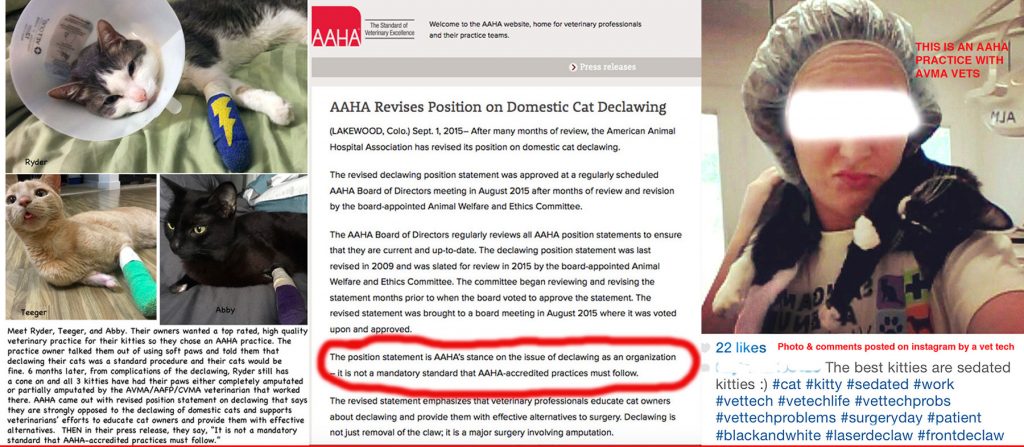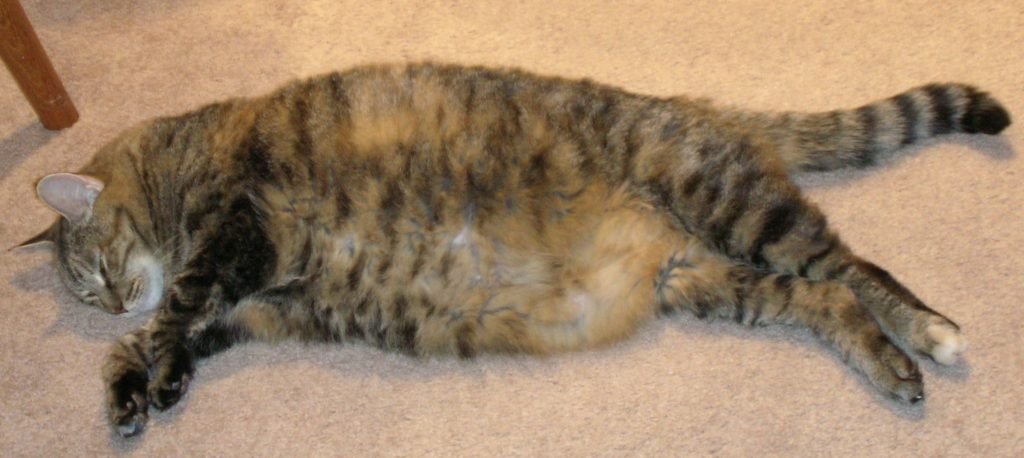American Animal Hospital Association (AAHA) says vet surgery can be dictated by owners.
If you ask an AAHA vet to amputate your dogs paws because it is digging holes in your back yard, will they do it?
If a dog owner calls up their vet and says that they want their dog declawed because it is ruining their new hardwood floors, will they do it? (Most won’t but there are a few like this one who will) [button href=”https://citythekitty.org/houston-humane-society-declaws-cats-guess-why/” newwindow=”yes”] HHS Board Member Declaws Dogs and Cats[/button]
If your cat is peeing all over the house and you ask your AAHA vet to remove one kidney as a warning, will they do it?
If your cat is jumping on your kitchen counter and you ask your AAHA vet to remove one paw to teach her a lesson, will they do it?
If you think your cat is fat and you ask your AAHA vet to give him a tummy tuck, will they do it?
If your dog is chewing up your pillows and you ask your AAHA vet to remove all of his teeth, will they do it? (Most won’t but here is one that did at the 8 min mark of this video) [button href=”http://oregon.granicus.com/MediaPlayer.php?view_id=6&clip_id=9885″ color=”red” newwindow=”yes”] Oregon Senator testifies for declawing bill [/button]
If pet owners started to ask for these mutilating and unnecessary surgeries and some AAHA vets started doing them, I’m fairly certain AAHA would say that they are against doing all of these unnecessary and inhumane surgeries and would say that they are forbidden at AAHA practices.
AAHA says they are STRONGLY OPPOSED to declawing, knows it is wrong and inhumane, and yet ALLOWS cat owners to be the ones to make that decision for their cats, which is NEVER in the best interest of a cat.
Most AAHA vets declaw cats and make good money doing that inhumane surgery, so AAHA won’t make their declawing position mandatory at AAHA hospitals or put in any standards for declawing.

A cat owner and supporter of our important cause to end declawing recently reached out to AAHA and asked them these questions in regards to their position statement on declawing and why they don’t have any standards of care for declawing.
Here is the email from the cat owner to AAHA-
Cats are essentially being maimed for no health benefit – in fact, declawing has been associated with a variety of health problems over the lives of declawed cats. Why would you not create standards to ensure that the practices you endorse are at least following your position statement? Why would you not evaluate practices based on their use of declawing? I find it hypocritical that you claim your accreditation means something when your standards don’t address an issue that vets would prefer not to be evaluated on. How many other issues do you not evaluate because vets ask you not to or because it would result in a significant loss of income for your members? If your concern is first and foremost with quality care, why would you bend on this issue?
You might ask why this issue is important to me. When I was younger, my family adopted a cat named Kitty. Twenty-five years ago, when this happened, before it became public knowledge of just how horrible it is, the vet didn’t so much ask, “Do you want her declawed” as assumed that we’d want her declawed at the same time she was spayed.
I don’t think my parents’ so much made a choice as just went along with what was presented to them as the norm. I will never forget bringing her home from the vet after the surgery (I was 13 or 14). I set her down and her paws broke open and blood flew everywhere.
At that point, I didn’t care what the vet said or what other people said – our cat was in unnecessary pain. We called the vet and they said we could bring her back in but that there was nothing they could really do. I held her in my lap (so she didn’t walk and bleed more), both of us covered in her blood, for 10 HOURS while the rest of my family went about their business. She wasn’t a touchy-feely cat, so this prolonged contact was stressful for her as well. But TEN HOURS of yowling in pain until she lost her voice and fell asleep with exhaustion and I could leave her to go to the bathroom and get something to eat.
NEVER, EVER, EVER again. I’ve never really forgiven my parents for that because it became obvious to me in the first few minutes after we brought her home that it was a HUGE, GLARING, UNFORGIVABLE MISTAKE.
This is an emotional topic for me. I look at parts of the world that already ban declawing and I can’t help but think that our lack of doing so is selfishness.
If you demand high quality from the vets your accredit, why do you not hold the line on declawing? It would seem to me that if you claim accreditation bestows honor on a practice, that your intentions would be honorable as well.
Katherine
Photo of Kitty the declawed cat
ANSWER FROM AAHA SPOKESWOMAN in July 2016-
Dear Katherine,
Thank you for reaching out, and for participating in our July BlogPaws chat.
I understand that this is an emotional topic – as a pet owner myself, I know how incredibly difficult it is to see one of your animals in pain.
None of our position statements are mandatory standards that accredited practices must follow – position statements demonstrate where AAHA as an organization stands on various welfare issues.
Their purpose is very different from that of our standards.They are not intended to establish a standard of practice that veterinary hospitals must follow.
As an organization, AAHA strongly opposes declawing and encourages veterinarians’ efforts to educate cat owners on positive alternatives to declawing. Similarly, AAHA also opposes canine devocalization, tail docking, and ear cropping.
Ultimately, the responsibility and final power rests with the pet owner as to whether or not they choose to declaw their cat, or dock their dog’s tail.
It is up to the pet owner to make the decision that is right for his or her pet.
While veterinarians are there to help counsel a pet owner on a possible course of action, the ultimate decision maker is the pet owner. Part of being a responsible pet owner is being an advocate for your pet and making the choice that is in their best interest – while a veterinary hospital is a partner in that choice, it is not their choice to make at the end of the day.
Thanks again for reaching out, and for being an advocate for cats.
Best,
Kate
Katherine Wessels, Senior Manager, Communications, American Animal Hospital Association, 12575 W Bayaud Ave, Lakewood, CO 80228-2021
Kate.wessels@aaha.org, Office: 720-616-1783 |
*** AAHA is opposed to non-anesthesia dentals and makes it MANDATORY for their hospitals. MANDATORY DENTAL PRESS RELEASE FROM AAHA [button href=”https://www.aaha.org/professional/media/new_mandatory_dental_standard.aspx” color=”red” newwindow=”yes”] AAHA DENTALS[/button]
This cat owner sent me a note with her concerns about AAHA’s answers-
I love how the woman didn’t even answer my question about why there aren’t standards for vets in regard to declawing. Instead, they cling to that stupid position statement and hope that no one notices that they could very easily adapt standards related to declawing (as a condition of accreditation).
I don’t understand why they won’t. Vets CHOOSE to be accredited. I’m sure some vets chose not to because they disagree with other standards – so it’s not like anyone would have to abide by the standards.
It just makes me so incredibly mad because they could really set an example and they choose not to. It’s hypocritical at best (aren’t their standards to ensure quality and good practice for vets?).
They brag about these wonderful standards and top vets attaining their accreditation but it doesn’t seem genuine when you consider they could very easily set standards for declawing. I’d be interested in seeing the statistics for declawing between AAHA accredited vets and non-accredited vets. After checking out the accredited practices in the area, they are the vets more run as businesses vs. practices.
My hypothesis is that they probably declaw more than non-accredited practices – because they are more money motivated. I know I’m preaching to the choir here. But the AAHA really left a sour taste in my mouth on this issue.
Katherine
![]()
Here are some comments from veterinarians about the answer that the AAHA spokeswoman gave to this cat owner.
Veterinarian 1- “AAHA Veterinary offices that offer non-anesthetic dentals are automatically disqualified from accreditation.
What is troubling is that the AAHA rep seems to be laying all of the responsibility for making medical decisions in the pet owner’s lap. While technically this may be true, pet owners are receiving guidance from their veterinarian. That is what I get paid for.
As a veterinarian, I don’t just do whatever the client wants me to do because they are the ultimate decision maker. I give my clients all legitimate medical options regarding the best care for their pet and we go from there. If the pet owner wants to do something that is medically inappropriate like declawing, they need to find themselves a new veterinarian.
Suggesting that veterinarians carry no responsibility for the outcomes of treatments they recommended is kind of nuts. Pet owners rely on our expertise and judgement when they make decisions.
Just like the AVMA (and AAFP), AAHA represents its membership. The calculus here is the question of if a stronger position statement on declawing will be perceived as detrimental to member veterinarians.
Like any business, they want to maximize their membership. Not pissing veterinarians off is a good way to do that. It’s politics and economics. Until a majority of veterinarians want to see the practice stopped, AVMA (and AAFP) and AAHA are unlikely to take a stronger stand.”
Veterinarian 2- “AAHA sets its own guidelines. Why doesn’t it simply say that declawing is below the standard of care?”
Veterinarian 3- “It’s ridiculous to “leave it to the owner” to make the right decision for their pet. That should be a veterinarian’s place to know this is NOT in the cat’s best interest.
If they are against this procedure as a whole, enough to form a committee and draft a position statement, it should be a standard of practice.
They dictate how vets practice in other areas, methods of sterility, anesthesia, pain management right down to the material of surgery room garbage cans (have to be stainless steel) and how deep a sink has to be, all in the interest of the animal. So why not AT LEAST make it a non-mandatory standard?”
Veterinarian 4 – Veterinarians work with owners to come up with treatment plans for their pets but owners do not mandate what a vet should do. There is truth to the fact that owners can decline treatments and we give them choices of treatments. But owners do not tell me how to practice medicine and can’t make me do things to their pets I don’t feel is in their best interest.
Owners can choose to follow my recommendations or not and vice versa. I have never compromised my values for an owner. Owners have no authority to make me perform any treatment I don’t consider in the pets best interest and that includes declawing or convenience euthanasia.
![]()
These are some of the many disgusting examples of how hundreds of cats are being unnecessarily tortured, maimed, and harmed by AAHA veterinarians who declaw cats.
Here is an AAHA hospital that promotes their laser declaws (even all four paw declaws.) Remember the laser machines cost around $35,000 so they have to do a lot of declaws to pay them back. [button href=”https://www.youtube.com/watch?v=M18mw6d00Yo” color=”red” newwindow=”yes”] Heartland Animal Hospital PC, Illinois Laser Declaw[/button]
Here is an AAHA vet that likes to promote his laser declaw in a video and at the 20 second mark , the cat appears to pull his paw away as the vet puts the burning laser beam on the claw [button href=”https://www.youtube.com/watch?v=SZw1NnO1xpo” color=”red” newwindow=”yes”] AAHA Laser Declaw Vet Video[/button]
AAHA allows their vets to promote declawing, offer coupons for declawing, not require take home pain meds for two paw declawed cats, talk cat owners OUT of the humane alternatives, and lie to and deceive cat owners about the facts about declawing and say that there are no long term negative consequences to declawing.
Here are more appalling examples of AAHA’s double standards and declawing [button href=”https://citythekitty.org/aaha-double-standard-no-accountability-for-declawing/” color=”red” newwindow=”yes”] AAHA’s Double Standards[/button]
And last note on this. AAHA says this in their declawing position statement,”AAHA believes the current data regarding behavioral issues following declaw is insufficient and will evaluate new scientific information as it becomes available.” (Sounds like the AVMA deceit that they say there are no scientific studies that show declawed cats have behavioral issues) [button href=”https://citythekitty.org/american-veterinary-money-association-deception-for-profits/” color=”red” newwindow=”yes”] AVMA Declawing Propaganda[/button]
It’s a fact that there ARE many studies that show that declawed cats have more behavioral issues and ALSO AAHA rejects studies that show there are behavioral issues and pain in declawed cats.
But they do accept studies like this one involving TWO CATS, to help their vets see a more affordable way to inhumanely amputate cat’s toe bones with Radio Frequency and this study says it is a “reasonable alternative” to laser declaw. It also says, “RF is not accompanied by the strict safety considerations and initial expense of acquisition of a CO2 laser.” In other words, it’s cheaper and easier to buy a radio frequency unit than a $35,000 laser machine to burn off the toe bones. [button href=”http://www.jaaha.org/doi/abs/10.5326/0460375?=” color=”red” newwindow=”yes”] Radio Frequency vs Laser Declaw[/button]



